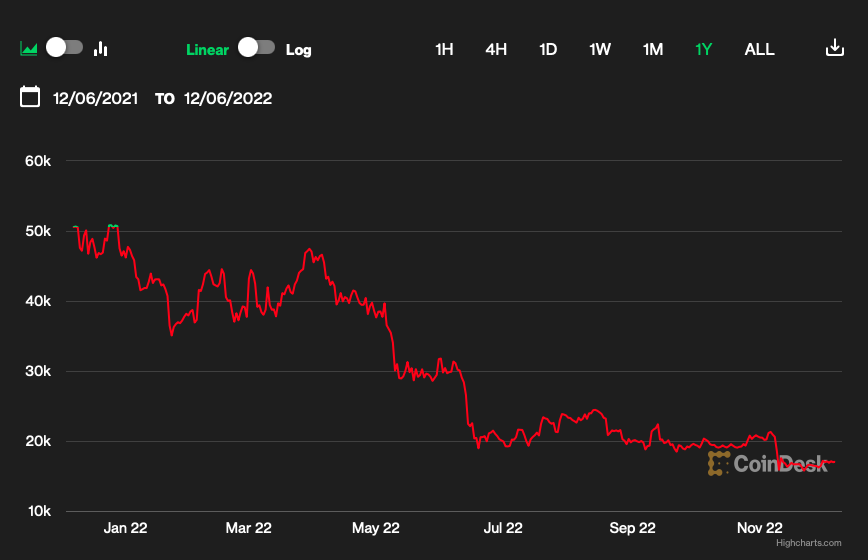The cryptocurrency market recently entered a “winter” of lower average asset values among a broad range of digital currencies, as a result of a string of calamities. The European Central Bank expressed its view of the recent events in stark words, predicting the irrelevance of Bitcoin. In this article, we try to decode the forecast and the diverging opinions surrounding the future of cryptos.
Ulrich Bindseil, director general of the European Central Bank, and Jürgen Schaaf, adviser, didn’t mince words in predicting the future of crypto assets. According to their recent blog post on the ECB website, the incoming irrelevance of bitcoins was already foreseeable long before the collapse of the crypto exchange FTX.
“The seeming stabilisation [of Bitcoin] is an artificially induced last gasp before the road to irrelevance.”
Stablecoins and crypto exchanges storms
Much like an apocalypse-styled event, this “crypto winter” started this summer following the collapse of TerraUSD and LUNA. The so-called stablecoins, dependant on market conditions, lost investors’ confidence in their value as the market itself declined (a result of combined overconfidence in tech companies’ quarterly growth, tightened interest rates by the U.S. policymakers, rising inflation and the overall crisis linked to the Russo-Ukrainian war).

Coindesk (last accessed: 06 December 2022) https://www.coindesk.com/price/bitcoin/
Before FTX’s notorious collapse, numerous crypto companies also paved the way to trouble for crypto enthusiasts: from the cryptocurrency lending company Celsius Network to the crypto hedge fund Three Arrows Capital and the brokerage service Voyager Digital, the rippling effects of their bankruptcies stress-tested the cryptomarket in real-time. Major crypto exchanges such as FTX are of course no exception to this trend: with valuation plummeting from $32 billion to bankruptcy, such an event was more than likely to worsen the ongoing fallout of decentralised finance around cryptocurrencies – with frozen accounts and ultimately, lost assets as a result.
There are no segregated accounts and recovery rules yet in the crypto world, although the incoming regulation on markets in crypto-assets (MiCA) is destined to protect consumers against some of the risks associated with the investment in crypto-assets.
“Swimming naked” in a frozen lake
In terms of risks linked to crypto, paraphrasing the famous quote of Warren Buffett seems appropriate. The current and sustained lower prices cannot be defined as bearish, since cryptocurrencies are not tied to valuation in the sense of traditional investments (meaning, cash flows or dividends). According to the ECB, crypto’s market valuation is essentially speculative, so the current status quo is closer to tiny waves under the surface of a frozen lake (the current 20k€ ceiling).
Add to this the innovative aspect of blockchain technology, and you get the expected result already seen with personal data protection in the European Union: an overdue regulatory effort and a short lifespan, as Axel Voss, one of the original authors of the GDPR, observed.
Back in 2013, Harvard Business Review made an interesting case about innovation risk: using the example of the four-wheel drive advent in bad weather conditions, it illustrates the biased belief that something created to make us safer will work in any type of condition or with any kind of behaviour. This belief spans from our inherent inability to foresee all consequences of new use cases, leading to risks of black swan events. Excessive enthusiasm may also span from techno-optimism, a deep belief in the resurgence of growth through innovation.
The ECB points out other non-negligible risks such as climate change, waste, and reputation. The first one finds its culprit in Bitcoin mining; the Global Impact of Crypto Trading report by Forex Suggest found that erasing Bitcoin mining carbon footprint would require panting around 300 million trees, to compensate for its annual 80 billion kWh burn and 60 million tons of CO2 emissions (for the year 2020). The second one is summarized as follows:
“Bitcoin mining […] produces mountains of hardware waste. One Bitcoin transaction consumes hardware comparable to the hardware of two smartphones. The entire Bitcoin system generates as much e-waste as the entire Netherlands”.
For Bitcoins promoters of the financial industry, reputational risk could ensue from growing losses sustained by investors following bubble bursts, even with a hypothetical market recovery.
“Weather” scrutiny spurs government efficiency
Other voices expressed more optimistic views on the topic: according to Fidelity International’s chief investment officer Andrew McCaffery,
“When you have something that obviously has such wide reverberations for that industry, […] it could bring the scrutiny, but actually the need, for regulation much closer to accelerate”.
No matter what the shockwave could entail for investors, more regulation would indeed serve the best interests of the cryptoassets ecosystem. A “wild west” kind of environment does not provide a trustworthy forecast, but more stringent rules would bring stability and clearer skies for investors. However, in the digital era, those rules need to be smart and sanction bad behaviours around innovation, not innovation itself.
In the European Union, MiCA will, among other things, protect investors against risks and fraudulent schemes. Service providers will find themselves liable in case of asset losses. New market abuse rules will also be applied. And ESMA will be tasked with the technical aspects of the environmental and climate footprint report associated with the regulation.
However, the ECB reminds investors that lawmakers’ involvement does not necessarily mean approval of the whole cryptomarket. It just means a safer, more structured environment for investors. It also prompts financial institutions to act with caution.
Momentum conservation
The energy invested in the cryptomarket may change form in the future, but it will probably not go down; despite “bad weather” and according to the ECB, “VC investments in the crypto and blockchain industry totalled USD 17.9 billion as of mid-July”. It shows that the momentum is still existing and will keep altering traditional asset systems.
Nasir Zubairi, Chief Executive Officer of the Luxembourg House of Financial Technology, says the collapse of FTX will create “jitters” in the market but the “momentum” for digital assets still exists.
“We’re still at a relatively early stage of the development of this market, even though it’s been around for about 10 years. But it will only continue to grow.”
With great powers come great responsibilities: entering the big league alongside traditional finance also means following the script on governance, compliance, risk and liquidity management, cybersecurity, and so on. It remains to be seen how much the introduction of regulation will modify the crypto environment and impact its notorious “Freedom to Transact”. It may also be the key to its survival and thriving.
Written by Oriane Kaesmann
Header image by Andre Benz on Unsplash






